Use Desktop for Better Experience
Equity Research: Starbucks Corporation (SBUX)
FINANCIALSELECTED
Ryan Cheng
8/16/202412 min read
Investment Recommendation
SELL
*
*Stocks and investments carry risks, including the loss of principal. The views expressed on this blog are solely the opinions of the author at the time of writing and are subject to change at any time without notice.
Company Overview
-Company Background-
Starbucks Corporation (SBUX), headquartered in Seattle, Washington, is the world's largest coffeehouse chain, renowned for its high-quality coffee and distinctive customer experience. Founded in 1971 by Jerry Baldwin, Zev Siegl, and Gordon Bowker, Starbucks initially focused on selling premium coffee beans and equipment. The company underwent a significant transformation under Howard Schultz, who joined in 1982 and later acquired the company in 1987, steering it towards becoming a global coffeehouse brand. Schultz introduced the concept of creating a "third place" between home and work, emphasizing the importance of community and customer engagement. Today, Starbucks operates over 30,000 locations worldwide, offering a wide range of products including coffee, espresso beverages, teas, and snacks.
-Products-
Starbucks is a global coffeehouse chain renowned for its extensive range of products that cater to various tastes and preferences. The product offerings are categorized into four main types: drinks, food, at-home products, and merchandise. Each category is designed to deliver the unique Starbucks experience to customers, whether they are in-store, at home, or on the go.
Drinks
Starbucks' drink menu is extensive, offering a wide variety of beverages to suit different palates. The coffee options include classic espresso beverages such as Espresso, Americano, Cappuccino, and Latte, all of which can be customized with different types of milk, syrups, and toppings. For those who prefer their coffee cold, Starbucks provides choices like Iced Coffee, Cold Brew, and the creamy Nitro Cold Brew. Additionally, seasonal favorites such as the Pumpkin Spice Latte and Peppermint Mocha bring a festive touch to the menu. Beyond coffee, Starbucks offers a range of Teavana® Teas and Refreshers™, which include fruity and herbal iced teas and revitalizing drinks like the Strawberry Açaí Refresher.


Food
Starbucks complements its beverage offerings with a diverse selection of food items. The breakfast menu includes options like the Classic Oatmeal, Egg Bites, and various breakfast sandwiches such as the Bacon, Gouda & Egg Sandwich. For a quick snack or lunch, customers can choose from an array of pastries, sandwiches, and protein boxes. Popular choices include the Ham & Cheese Croissant, Spinach, Feta & Egg White Wrap, and the Chicken & Quinoa Protein Bowl. Sweet treats like the Chocolate Croissant and Blueberry Muffin are perfect for those looking for a delightful indulgence.


At Home
Starbucks extends its experience to customers' homes with a range of at-home products. These products include Starbucks® Coffee Beans, Ground Coffee, and K-Cup® Pods, allowing customers to brew their favorite Starbucks coffee in the comfort of their own kitchens. The at-home collection features popular blends such as Pike Place® Roast, Veranda Blend®, and Espresso Roast. Additionally, Starbucks offers ready-to-drink options like bottled Frappuccino® beverages, Cold Brew, and Doubleshot® Espresso drinks, making it convenient for customers to enjoy Starbucks quality without the need to brew.
Starbucks also offers a variety of merchandise that enhances the coffeehouse experience. The merchandise range includes stylish and functional items such as Reusable Cups, Travel Tumblers, and Mugs. These products are designed with both aesthetics and practicality in mind, featuring designs that reflect the Starbucks brand. Seasonal collections and limited-edition items often become highly sought after by Starbucks enthusiasts. In addition to drinkware, Starbucks also sells coffee brewing equipment and accessories, including French Presses, Pour-Over Sets, and Coffee Grinders, enabling customers to recreate the Starbucks experience at home.
Merchandise




*Some locations offer beer, wine and energy drinks.
Industry Analysis
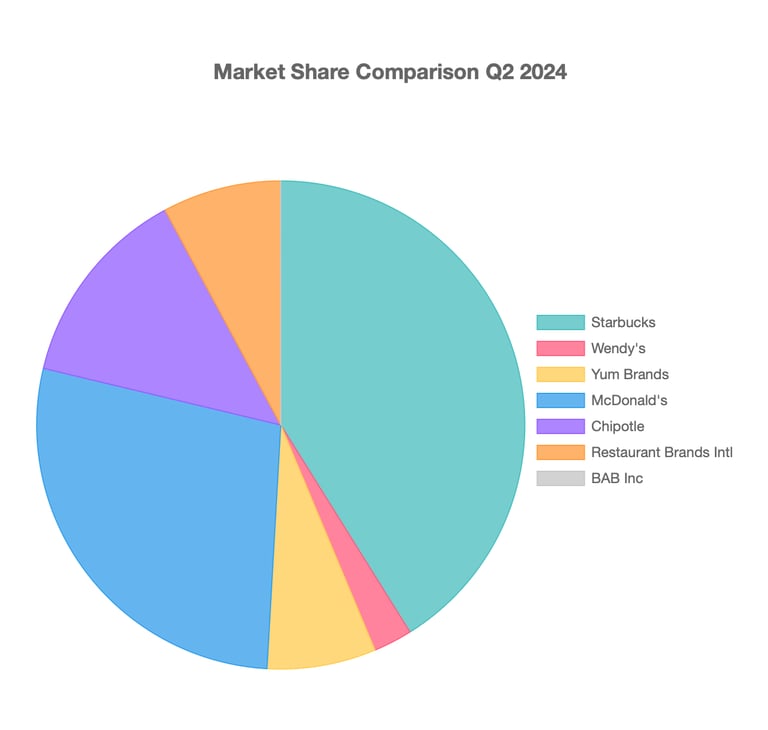

Starbucks stands as a dominant force in the global coffee shop industry, boasting a significant market share as of Q2 2024. The brand is widely recognized for its premium coffee offerings and customer-centric experience, which have established it as a leader in the sector. Competing against major players such as Wendy's, Yum Brands, McDonald's, and Chipotle, Starbucks maintains a strong foothold through its extensive network of stores and innovative marketing strategies.
*Source: CSI Market
-Catalysts for Market Growth-
The coffee shop market is poised for significant growth, driven by several key catalysts. One of the primary factors is the expansion into emerging markets, where a growing middle class is increasingly adopting coffee culture. Regions such as Asia and Africa present vast opportunities, as consumers in these areas are becoming more affluent and open to premium coffee experiences. By strategically establishing a presence in these markets, coffee shops can tap into new customer bases and drive sales.
Product diversification also plays a crucial role in stimulating market growth. As consumer preferences shift towards healthier and more varied options, coffee shops are capitalizing on this trend by introducing innovative beverages and food items. Seasonal offerings, plant-based alternatives, and specialty drinks can attract a broader audience, catering to those seeking unique tastes and healthier choices. This adaptability not only meets customer demands but also enhances brand loyalty.
Technological advancements are transforming the coffee shop experience, further contributing to market growth. Mobile ordering and payment systems have streamlined customer interactions, making it easier for consumers to enjoy their favorite beverages. Enhanced loyalty programs, facilitated by digital platforms, encourage repeat business and deepen customer engagement. By embracing technology, coffee shops can improve operational efficiency and attract tech-savvy consumers.
Sustainability initiatives are increasingly influencing consumer choices, making them a critical catalyst for growth. Coffee shops that commit to environmentally friendly practices, such as sourcing sustainably and minimizing waste, resonate with eco-conscious consumers. This focus on sustainability not only enhances brand image but also fosters customer loyalty, as consumers are more likely to support businesses that align with their values.
Strategic partnerships can also drive growth in the coffee shop market. Collaborating with local brands, food suppliers, or even lifestyle companies can create unique offerings and attract diverse customer segments. These partnerships can open new distribution channels and enhance brand visibility, making coffee shops more competitive in a crowded market.
-Porter's 5 Forces Analysis-
Threat of New Entrants
The coffee shop industry has a moderate threat of new entrants. While the initial investment for starting a coffee shop can be relatively low, established brands like Starbucks create significant barriers through brand loyalty, economies of scale, and strong supply chains. New entrants must also navigate regulatory requirements and competition from existing players, which can deter many potential competitors. However, niche markets and specialty coffee shops can still emerge, appealing to specific consumer preferences.
Supplier
Power
The bargaining power of suppliers in the coffee shop industry is moderate. While there are many coffee suppliers, a few key players dominate the market, especially for high-quality beans. This concentration can give suppliers some leverage, particularly for specialty or organic products. However, coffee shops can mitigate this risk by diversifying their supplier base and forming long-term relationships with multiple suppliers, allowing them to negotiate better terms.
Buyer
Power
The bargaining power of buyers is high in the coffee shop industry. With numerous options available, consumers can easily switch between brands or shops based on price, quality, and service. The rise of specialty coffee shops and fast-casual dining options has increased competition, giving consumers more choices. Additionally, the growing trend towards health-conscious and sustainable products means that coffee shops must continually adapt to meet customer expectations, further increasing buyer power.
Threat of
Substitution
The threat of substitutes is also high in the coffee shop industry. Consumers have a variety of alternatives, including home brewing, tea, energy drinks, and other beverage options. The convenience of preparing coffee at home or purchasing ready-to-drink options from supermarkets can divert customers away from coffee shops. To combat this threat, coffee shops must differentiate themselves through unique offerings, exceptional customer service, and a strong brand experience.
The intensity of rivalry within the coffee shop industry is high. Established players like Starbucks and Dunkin' Donuts compete not only among themselves but also with a large number of independent coffee shops and specialty cafes. This competition drives innovation and marketing efforts as companies strive to attract and retain customers. Price wars, promotional campaigns, and loyalty programs are common strategies used to gain market share, further intensifying the competitive landscape.
Competitive
Rivalry
Investment Catalysts
-Hard Catalysts-
Global Expansion Strategy
Starbucks is strategically expanding its footprint in emerging markets, with a particular focus on Asia. This region presents a unique opportunity for growth as countries like China and India are experiencing a rising middle class and a growing appreciation for coffee culture. By entering these markets, Starbucks can tap into a vast customer base that is increasingly looking for premium coffee experiences. The company’s approach often includes adapting its menu to local tastes, which helps establish a strong connection with consumers. This tailored strategy not only drives immediate sales but also fosters brand loyalty, positioning Starbucks to capitalize on long-term growth in these high-potential markets.
Innovative Product Offerings
Innovation is at the heart of Starbucks’ strategy, with the company regularly introducing new and seasonal products to keep its menu dynamic. This commitment to innovation not only attracts new customers but also encourages repeat visits from existing patrons. Seasonal drinks, limited-time offerings, and unique food pairings create buzz and excitement around the brand, driving foot traffic and boosting sales during peak seasons. Additionally, by responding to trends such as health and wellness, Starbucks can introduce products that resonate with evolving consumer preferences, further enhancing its market appeal and sales potential.
Loyalty Program Success & Strong Brand Equity
Starbucks' loyalty program has become one of the most successful in the retail sector, boasting millions of active members. This program incentivizes repeat purchases through rewards, personalized offers, and exclusive promotions, significantly driving customer retention. The data collected from loyalty members also allows Starbucks to tailor marketing efforts and product offerings, creating a more personalized experience. Coupled with strong brand equity, Starbucks enjoys a competitive advantage in the coffee shop market. Its reputation for quality and customer service fosters trust and loyalty, making customers more likely to choose Starbucks over competitors. This combination of a robust loyalty program and strong brand recognition not only stabilizes revenue but also enhances the company’s ability to attract new customers, ensuring sustained growth over time.
-Soft Catalysts-
Cultural Relevance
Starbucks has effectively positioned itself as more than just a coffee shop; it embodies a lifestyle brand that resonates deeply with contemporary cultural trends. By aligning with values such as social responsibility and inclusivity, Starbucks appeals particularly to younger consumers who prioritize brands that reflect their beliefs. This cultural relevance enhances customer loyalty and attracts a demographic that seeks meaningful connections with the brands they support. Starbucks frequently engages in social issues, creating campaigns and initiatives that promote diversity and community involvement, further solidifying its status as a brand that stands for more than just profit.
Commitment to Sustainability
Starbucks’ commitment to sustainability is a significant soft catalyst for investment. The company actively pursues initiatives aimed at reducing its environmental footprint, such as minimizing plastic waste and promoting ethical sourcing of coffee. These efforts resonate strongly with environmentally conscious consumers who are increasingly making purchasing decisions based on a brand’s sustainability practices. By supporting farmers through fair trade programs and investing in eco-friendly packaging, Starbucks enhances its brand image and attracts customers who prioritize sustainability. This alignment with consumer values not only strengthens brand loyalty but also positions Starbucks favorably in a market that increasingly values corporate responsibility.
Valuation
-DCF Model-
By using a 5-year discounted cash flow (DCF) model, Starbucks Corporation is determined a fair value of $55.63. This indicates a potential downside of 28.54% from its current price of $77.85 (30/06/2024).
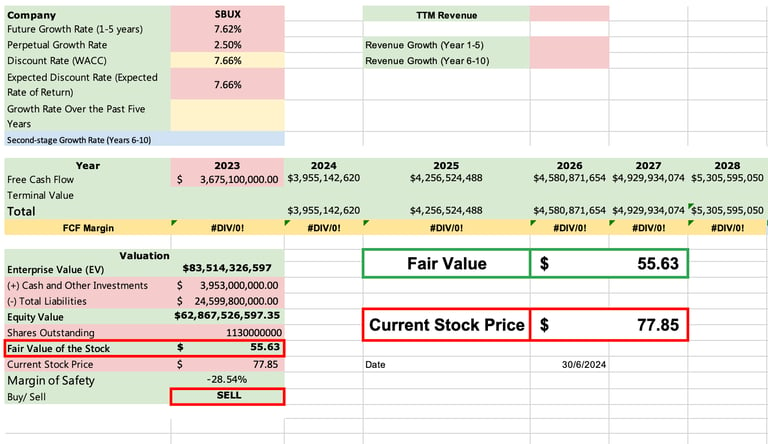

*Data is extracted from Yahoo Finance, GuruFocus, and Simply Wall Street
**Perceptual Growth Rate is estimated as 2.5%, as the historical inflation rate of United States is between 2%-3%
Risk Management and Mitagations
By addressing these risks through targeted mitigation strategies, Starbucks can strengthen its market position, enhance employee relations, and protect its brand reputation in a challenging environment.
Intense Competitive Landscape
Starbucks operates in a fiercely competitive environment, facing challenges not only from traditional coffee shops but also from fast food outlets that offer more attractive pricing. In particular, the rise of Luckin Coffee in China, which has rapidly expanded and overtaken Starbucks as the largest coffeehouse chain in that market, highlights the need for the company to adapt. To mitigate these competitive pressures, Starbucks can focus on product differentiation by emphasizing unique offerings, such as premium coffee blends and innovative beverages. Additionally, introducing value-oriented products and promotions can attract price-sensitive consumers. Tailoring the menu and customer experience to local preferences, especially in competitive markets like China, will further enhance its appeal. Strengthening the Starbucks Rewards program is also crucial, as it encourages repeat business and fosters deeper customer engagement.


Tensions with Unions
Ongoing tensions with unions present another significant risk for Starbucks. Labor disputes can disrupt operations and negatively impact employee morale. To address these challenges, it is essential for the company to foster open communication with employees and union representatives, proactively addressing concerns before they escalate. Investing in employee engagement through training, benefits, and career development opportunities will enhance job satisfaction and reduce the likelihood of disputes. By adopting a collaborative approach that seeks mutually beneficial agreements, Starbucks can mitigate labor-related risks while maintaining operational efficiency.
Starbucks has faced boycotts and social tensions, particularly in regions like the Middle East, which can adversely affect sales and brand perception. Developing a robust crisis communication strategy is vital for addressing negative publicity quickly and effectively. Engaging with local communities to better understand cultural sensitivities will help build stronger relationships and improve brand reputation. Additionally, enhancing corporate social responsibility (CSR) initiatives can demonstrate Starbucks' commitment to social issues and local communities, reinforcing its positive image. By proactively managing these risks, Starbucks can protect its brand and sustain its market position in challenging environments.
Boycotts and Social Tensions
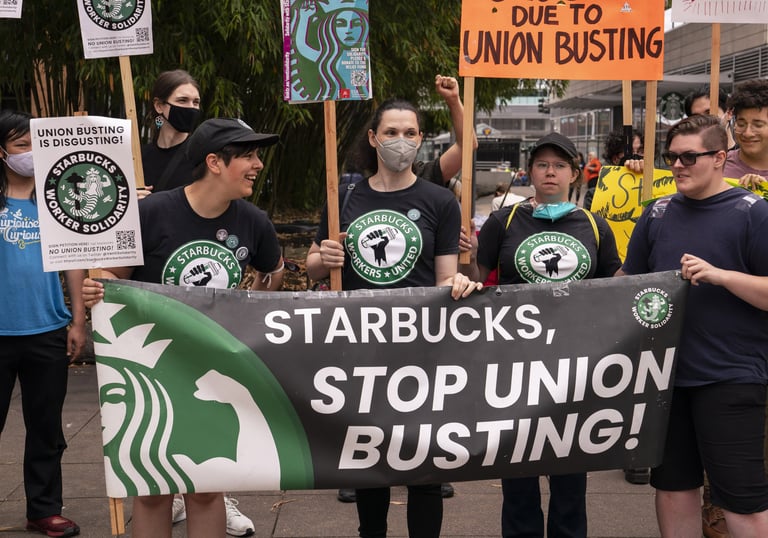



Starbucks' New Cold Drink Cups and ESG Analysis
Starbucks has recently unveiled a new line of cold beverage cups that utilize up to 20% less plastic than their previous versions. This initiative is a significant step in the company’s broader sustainability goals, aligning with its commitment to reduce carbon, water, and waste footprints by 50% by 2030. The introduction of these cups highlights Starbucks' proactive approach to addressing environmental concerns in the beverage industry.
The environmental impact of the new cups is noteworthy. They are projected to save more than 13.5 million pounds of plastic from landfills annually, tackling the escalating issues surrounding plastic waste. Additionally, the production of these cups is expected to cut emissions equivalent to about 5,200 cars off the road each year, demonstrating Starbucks' commitment to mitigating its carbon footprint. Furthermore, the new cups are anticipated to conserve approximately 2,800 Olympic-sized swimming pools of water, reflecting a significant reduction in resource consumption.
In terms of social considerations, Starbucks has incorporated accessibility features into the design of these cups. Raised dots indicate sizes for those with low visibility, while embossed letters on the bottom aid in easy identification during busy periods. This commitment to inclusivity enhances the customer experience and aligns with broader social responsibility goals. Moreover, by allowing customers to use reusable cups for drive-thru orders and mobile app purchases, Starbucks encourages active participation in sustainable practices, fostering a community-oriented approach to environmental stewardship.
From a governance perspective, Starbucks' initiative is part of a larger framework of Environmental, Social, and Governance (ESG) strategies. The company’s transparent goals and measurable outcomes reflect a robust governance structure that prioritizes sustainability and corporate responsibility. By addressing environmental concerns and promoting sustainable business practices, Starbucks demonstrates accountability to its stakeholders, including customers, employees, and investors.
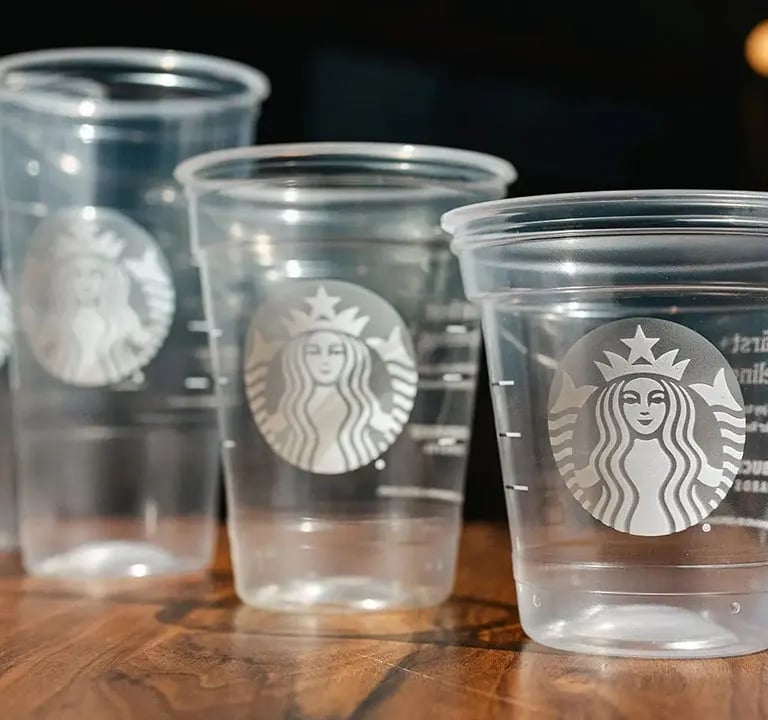

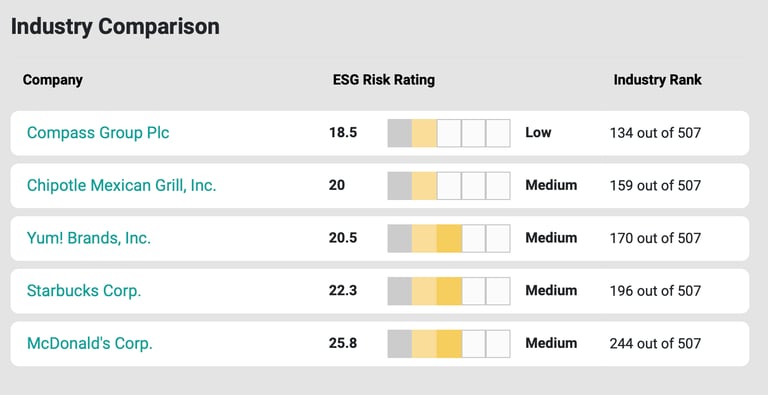

Starbucks ESG Performance
Source: Sustainalytics
Disclaimer
This report is intended solely for informational purposes. The information contained herein is general and does not take into account the specific circumstances of any individual or entity. It is your sole responsibility to thoroughly evaluate the advantages and risks associated with utilising any information presented in this report before making any decisions.
Investing in securities carries inherent risks. Stocks, bonds, exchange-traded funds (ETFs), mutual funds, money market funds, and other financial products all involve the risk of potential loss, and it is possible to lose the principal amount invested. Certain high-risk investments may employ leverage, which can amplify both gains and losses. Foreign investment entails particular risks, including increased volatility as well as political, economic, and currency risks and disparities in accounting practices. The past investment performance of a security or a firm does not guarantee or predict future investment performance.
Ryan Financial Blog will not receive direct or indirect compensation in exchange for expressing views in this report.


